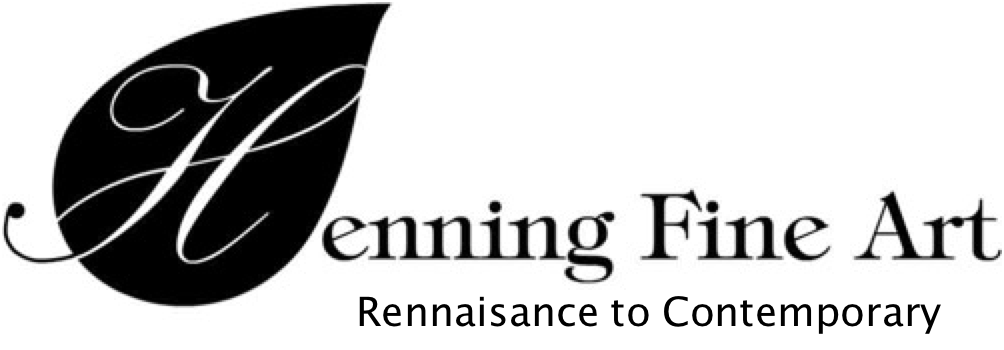Romeo Villalva Tabuena (1921 - 2015)
Romeo Villalva Tabuena (1921 - 2015)
Romeo Villalva Tabueno (1921 - 2015)
"Untitled Philippine River Landscape"
Watercolor on Paper
17 x 29 inches (painting)
23.25 x 35 inches (frame)
Signed in Plate: "Tabuena" (low left)
Dated: 1959
Up for sale is an exceptionally fine painting by the renown Filipino artist Romeo Villalva Tabuena depicting an untitled Philippine river landscape. Executed in watercolor on paper this large composition measures 17 x 29 inches while its contemporary frame measures 23.25 x 35 inches. Depicting a man rowing a long boat along the smooth waters surface at sunset; the entire atmosphere is cast with attractive orange and purple tones. The painting shows a minimal middle ground decorated with a small slice of land with waving grass and six tall palm trees set against a single large mountain in in the background. Signed “Tabuena” in the low left corner the painting is dated 1959 which was the year of his significant ten year retrospective at the Philippine Art Gallery in Manila. This is a highly attractive landscape painting showing great color, composition and execution with the expressionist style of splattering and letting watercolor run down the papers surface. The condition of the work does show some minimal imperfections like a light waviness to the sheet, some creases along the outer edges of the sheet, light matt burn and a surface abrasion located at the front of the boat. The images provided accurately represent the quality, condition and aesthetic beauty of this gorgeous Romeo Tabuena painting but if you have any questions please feel free to ask prior to purchasing!
ARTIST BIOGRAPHY
___________________________
Filipino postwar Neo-realist painter and printmaker Romeo Tabuena experienced life, education, and culture around the globe, from his birthplace in Southeast Asia to his residence in Mexico. Active in the Philippine Art Gallery, which opened in 1951, Tabuena created groundbreaking works that contributed to the evolution of art in the Philippines. In an interview, Tabuena stated that Cubism and Chinese vertical format painting greatly influenced him. Most of Tabuena's works are acrylics, oils, and watercolors that feature a combination of Filipino and Mexican cultural themes, such as the everyday working people, traditional housing, and native plants. Some of Tabuena's watercolor landscapes are his most sought after works.
Born in Iloilo City, Philippines in 1921, he earned an architecture degree from the Mapúa Institute of Technology in Manila and a painting degree from the University of the Philippines. His talents were first recognized around 1949, when he held numerous exhibits at the Philippine Art Gallery where he displayed his watercolors and drawings.
Tabuena wanted to learn more from the Masters, so he left the Philippines to study at the Art Students League of New York in 1952 and at the Académie de la Grande Chaumière in Paris in 1954. In 1955, he moved to San Miguel de Allende, Mexico—which, at the time, was an up and coming artist community—where he would paint for decades to come. Tabuena kept his Philippine citizenship, although he has not since returned to the Philippines. The work he produced while in Mexico includes colors from the entire spectrum and features common people, such as street vendors and laundry women. Bibsy M. Carballo described Tabuena as "a gentle soul who appreciated good food, friends, [and] the many similarities between Mexico and the Philippines". While living a humble and simple life in Mexico, Tabuena met his wife, Nina, a Swiss woman who also studied art and learned about her future husband through American Artist magazine.
Despite his geographic separation from the Philippines, Tabuena preserved connections with his homeland. He participated in exhibitions and important art projects, including a ten-year retrospective at the Philippine Art Gallery in Manila in 1959 and a noteworthy solo exhibition sponsored by the Philippine government at Mexico City's International Salon of the Palace of the Fine Arts in 1962. This show "further elevated the status of Philippine painting in the world of contemporary art". Other solo exhibitions included Manila in 1973, Mexico City in 1975, and another in Manila at the Galerie Bleue in 1981.
Tabuena has received several honors for his works. He won a second place award in 1949 from the Art Association of the Philippines for Agnus Dei (Lamb of God) and an honorable mention in 1952 for Black Christ. Both the Philippine and Mexican governments have recognized Tabuena's artistic contributions. The Instituto de Bellas Artes sponsored a major exhibit of Tabuena's work in 1995. In 2000, per a cultural agreement between the two countries, a Millennium Show was held in Tabuena's honor and in 2007, the Philippines awarded him the Presidential Merit Award.
Tabuena is listed in the "Who's Who" of both internationally renowned artists and intellectuals. Tabuena served as the official artist and art commissioner from the Philippines at the Eighth São Paulo Art Biennial in 1965. One of his major works, a mural titled Filipiniana, painted in 1957, was commissioned by the Philippine government and is on display in the Philippine embassy in Washington. D.C. Another of his principle works, an animal painting, Carabao, is on display at the Honolulu Museum of Art. The New York Public Library, the Philippine National Museum in Manila, the Palace of Fine Arts and MoMA in Mexico City, and the MoMA in São Paulo, Brazil also feature Tabuena's work. The Ayala Museum has displayed Tabuena's work twice.
Source: Kristin Guess for Tobin Reese Fine Art










